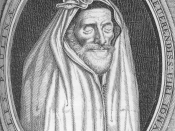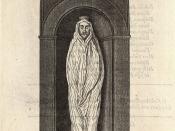John DonneÃÂs A Valediction: Forbidding Mourning is a distinctive metaphysical poem about love and the connection of passion and feelings. He believes the love with his wife will help them go through the harshness of separation, as it will only strengthen the relationship with his lady.
Using skillfully the figure of speech in his poem, John Donne expresses his love to his wife through the valediction. As they have to endure the separation, he compares the loss feeling to death. Donne mentions ÃÂvirtuous menÃÂ as they are immortal; for their souls may part the bodies but the living ones still long for them (Brackett.) He writes:So let us melt, and make no noise,No tear-floods, nor sigh-tempests move;'Twere profanation of our joysTo tell the laity our love.
He tells his wife to stay calm and do not cry since making such a miserable scene is the action ÃÂlaity peopleÃÂ do. He assures her they are not common people, so they should keep their deep emotion inside as it would be overwhelming the parting scene.
In the next stanza Donne refers to ÃÂTrepidation of the spheresÃÂ as the moving of the Earth. At that time people believed the Earth is center of the universe and other planets moving around it (Brackett.) Therefore this image links to the compass and the circle symbols later on in the poem, with its everlasting spinning of the Earth, just like the loverÃÂs romance. Unlike that eternal relationship, the ÃÂdull sublunary loversÃÂ cannot bear absence. They would not understand the need of bonding even when being apart. Donne and his wife have the type of romance that is ÃÂso much refinedÃÂ, they cannot even understand it. Their relationship is not only about missing the eyes, the loverÃÂs lip or the warmth of their hands. The missing feeling here is missing a part of themselves. Though the missing is hard to ear, believing in the otherÃÂs return helps them get through the separation. On the following stanza Donne talks about the reunionÃÂs sight:Our two souls therefore, which are one,Though I must go, endure not yetA breach, but an expansion,Like gold to airy thinness beat.
When two souls meet they form a complete whole, a perfect circle. The time when they are separated only brings them closer together, like gold jewelry gets longer after time of use. They do not break, they expand even more.
Indicating the two souls blending in as one, Donne uses the most famous metaphor in the poem: the stiff compass. They are too parts of a same one compass, with one moves accordingly to the other. When they are together they make a stable stand at one point, when separated they still attach with the same part and make a perfect circle. This imagery continues in the last stanza, where the poet feels eager to come home, and like one leg of a compass, willingly go back to the other one firmly stands strong waiting, to reunite as one.
With the use of several metaphors and rich imagery, John Donne creates a marvelous work dedicating it to his wife. His assuring voice makes the long separation seems not so tough anymore, but a chance to prove their strong bond with each other.
Works citedBrackett, Virginia. "'A Valediction Forbidding Mourning'." Facts On File Companion to British Poetry, 17th and 18th Centuries. New York: Facts On File, Inc., 2008. Bloom's Literary Reference Online. Facts On File, Inc. http://www.fofweb.com/activelink2.asp?ItemID=WE54&SID=1&iPin=CBP1029&SingleRecord=True (accessed June 17, 2009).
Donne, John. A Valediction: Forbidding Mourning. 1611. Rpt. in Compact Literature Reading Reacting Writing. By Kirszner





